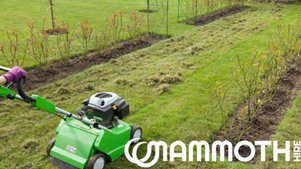How to use a scarifier

A lawn scarifier is a machine on wheels similar to a lawn mower with a series of blades underneath. These blades turn over the lawn to tease out thatch. An electric scarifier is ideal for a small garden, anything larger may need a petrol scarifier.
When to scarify your lawn
Ideally, you should scarify your lawn once a year, in spring or early autumn when the grass has a chance to grow back and recover after the process.
You should avoid scarifying your lawn after harsh weather such as heavy rain as the grass will not be able to grow back and recover well.
Removing weeds
Before you begin scarifying your lawn, you should remove any large weeds on the lawn. You should also apply a moss killer to any patches of moss on your lawn around 1-2 weeks before scarifying.
How to use a scarifier for your lawn
Before scarifying your lawn, cut the grass with a lawn mower on a low blade setting. This exposes the moss and thatch.
Next, use the scarifier the same way as the lawn mower, following the same lines you created when you cut the grass.
Set the scarifier blades on a high setting at first. If you go straight in with a low setting you can shock and damage the grass. Complete a few passes over the lawn, at different angles, lowering the blades a little each time.
As you scarify the lawn, you will remove the moss and thatch. Also, the blades will prune the grass to encourage thicker growth.
What to do after you have scarified your lawn
You can also aerate the lawn using an aerator (or 'hollow tiner'). This is a similar process to scarifying, but the aerator's tines punch tiny holes into the lawn. This improves drainage and encourages healthier grass growth.
As moss thrives in damp areas, aerating the lawn will help to prevent future moss growth by improving drainage. Aerating the lawn will also allow water, nutrients and air into the soil to feed the grassroots and improve grass growth.
Overseeding your lawn
Once you have finished scarifying your lawn, there may be bare patches where the moss and thatch once thrived. Overseeding involves scattering new grass seed over your lawn to fill gaps and promote thicker grass growth. This is a key process after you've scarified and aerated your lawn.
Scarifying and aerating your lawn leaves a nice seedbed for fresh seed to thrive. During overseeding, spread seed over the entire lawn but give special attention to fill the bare patches of lawn.
Once you have completed the overseeding, keep the soil moist with regular light applications of water. Though take care not to saturate the soil.
Keep traffic over the lawn limited following overseeding to give the seed a chance to grow. You can even cover areas of the lawn with a mesh to prevent birds stealing the seed!
When you mow the lawn in the weeks following scarifying, raise the height of the mower blades to give the seed a chance to establish.
Feeding the lawn
In the weeks following the laying of fresh seed, you can also use fertiliser to assist in the rich and healthy growth of your rejuvenated lawn. You should use a granular spring/summer fertiliser, as this has high levels of nitrogen and other nutrients like phosphate. Granular feeds perform better when the ground is still a little cold and growth is still patchy, so they work very well in spring.
For small areas, you can spread the fertiliser by hand. For convenience over larger areas, you can use a fertiliser spreader to ensure even distribution of fertiliser.
A good feed with a lawn fertiliser not only makes the grass greener. It also helps the grass to grow thicker, increases its strength and improves the health of the lawn. A well fertilised lawn is much more robust and better equipped to compete with weeds, moss and weather-related stresses.
If you feed the lawn again 6 weeks after the initial feed, it will remain strong and healthy all summer.
As the fresh seed takes to the lawn and starts to grow, you will soon notice the difference in your lawn. Where there was once thatch, weeds and moss, there will be healthy, rich, green grass. Also, as you aerated your lawn to improve drainage and allow nutrients into the soil. The new grass should flourish throughout the summer.



